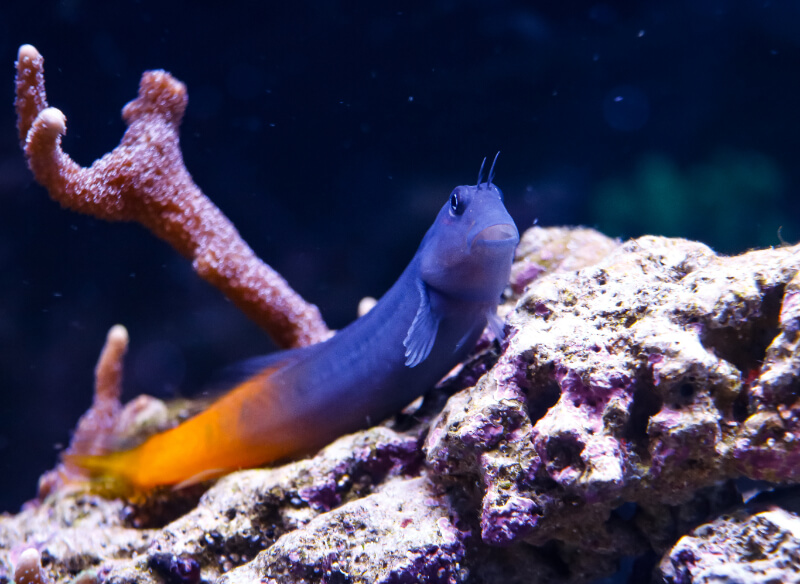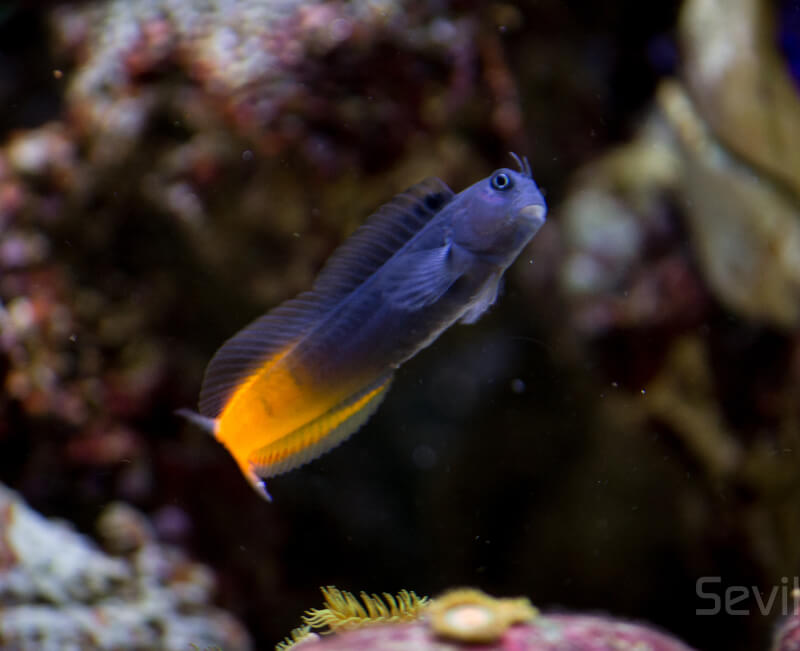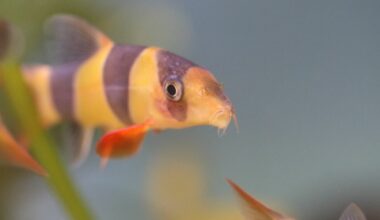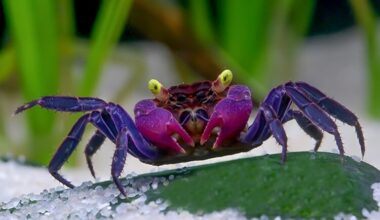Greetings, fellow saltwater aquarists! We’re thrilled to present to you our comprehensive care guide for the delightful Bicolor Blenny.
These quirky fish have a unique ability to perch themselves on rocks or corals, giving them a comical and endearing appearance. They seem to have mastered the art of being both fish and a living statue!
We’re excited to guide you on this aquatic journey, so let’s dive in together and unlock the secrets to the Bicolor Blenny’s happiness and well-being!
Table of Contents
Species Summary
Known under the scientific name Ecsenius bicolor, the Bicolor Blenny is found in the waters surrounding Fiji, Sri Lanka, the Maldives, and Indonesia. In fact, this fish is a familiar face among divers exploring exotic Indo-Pacific lagoons and reefs.
Author Note: Due to its radiant lower half, this bi-color fish is sometimes called the Flame-Tail Blenny. These tiny champs really know how to chomp!
A natural “worker bee” of the seas, the Bicolor Blenny is a comb-tooth fish with rows of tiny, comb-like teeth lining its jaw to help busily strip algae from corals and rocks. Tank owners love the way these fish help to “clean up.”
With a price around $16 to $30 and larger fish selling for as much as $80, the Bicolor Blenny provides an option to own a beautiful, exotic fish for a much lower price compared to fish of matching magnificence.
Appearance
The Bicolor Blenny can almost look like a slim eel darting across a tank if you look quickly! The long, slender body of this fish can make it seem like some kind of ancient ray-finned fish from the deep! However, there’s simply no mistaking this fish’s unique body consisting of a blue top half and orange-yellow bottom half once you look closely.
Author Note: The Bicolor Blenny is also identified by its single ultra-long dorsal fin. It has large, protruding eyes that merge with antennas to create what some might describe as an alien-like look.
Male and female Bicolor Blennies can look remarkably different. During breeding, the male undergoes dramatic color changes that turn it a deeper blue. Males are also generally much brighter than females. The orange “flame” on the tail half of the female is far duller than the flame on the male.
The fins of males and females are also different. In fact, the way to know that you’re looking at a male Bicolor Blenny is to look for extended fin rays. The female lacks this feature. Additionally, the male’s anal and dorsal fins are larger. The male Bicolor Blenny is usually larger than the female one.

Lifespan
While this blenny can produce unending awe, the fish isn’t known for an unending lifespan. The Bicolor Blenny typically has a lifespan of 2 to 4 years in the wild and as much as 10 years in captivity. The shorter lifespan mostly has to do with its lack of camouflage in its natural habitat, but in an aquarium with the proper care and attention you can keep this fish for many more years!
Average Size
While the average size of a Bicolor Blenny is 3 inches, it’s not uncommon for this fish to reach 4 inches. Males are generally larger than females.
Bicolor Blenny Care
The Bicolor Blenny can be considered a good fish for beginners due to its even temperament and basic tank requirement, as long as there’s enough commitment to keep this fish healthy and thriving!
Tank Size
The recommended tank size for a Bicolor Blenny is at least 30 gallons. Due to the fact that these fish are accustomed to jumping from pool to pool in the wild, they appreciate larger swimming areas. The larger tank size is also needed to house the living rocks and hiding structures that the Bicolor Blenny needs to feel safe and content. A cramped tank can turn this docile fish aggressive!
Author Note: Just make sure that the tank is covered to keep these infamous jumpers safe!
Water Parameters
- Water temperature: 75 to 80°F
- pH levels: 8.1 to 8.4.
- Water hardness: 8 to 9.5 dKH
- Specific gravity: 1.024 to 1.025
Tank Setup
The Bicolor Blenny tends to cling to the bottom of the tank to satisfy its desire to recreate its natural habitat among rocks and corals. It will be drawn to hiding spots and crevices. When creating a tank for a Bicolor Blenny, take time to scatter rock particles all along the tank floor.
These fish also appreciate live rocks that can be used to create natural ledges and caves for hiding. Mature live rock is preferred over fresh rock because “seasoned” environments are healthier for the Bicolor Blenny compared to sterile environments. Remember that this fish will be counting on algae attached to structures within the tank environment to thrive!
Are Bicolor Blennies Reef-Safe?
There’s some nuance to this answer. The Bicolor Blenny is technically a reef safe fish due to the fact that it’s “mostly” an herbivore. There’s simply no reason for a Bicolor Blenny to go after coral when there’s algae on the menu! However, this fish will turn its appetite toward coral if it’s not being properly fed.
The Bicolor Blenny will also sometimes turn aggressive enough to munch on coral if it’s in distress due to overcrowding. Maintaining a good feeding schedule, cultivating algae, and keeping a tank uncrowded will ensure that the Bicolor Blenny doesn’t nip at coral.
Common Possible Diseases & Prevention
While the Bicolor Blenny isn’t more susceptible to disease than other fish, tank owners still need to be cautious about the ever-looming risks for marine velvet and ich. The telltale sign of marine velvet is a thin dusting of yellow or pale powder over the fish. Fish infected with marine velvet may also show signs of lethargy and respiratory distress.
Author Note: If a Bicolor Blenny has ich, it may be observed scraping its body against objects in the tank. Of course, the more obvious sign of ich is the presence of salt-like white spots peppering the gills and body.
The best way to prevent the spread of any type of disease among tropical fish is to quarantine new tank additions for up to eight weeks before adding them to an aquarium. Always inspect new fish closely. If any fish is showing sings of illness, place it in a quarantine tank away from all other fish immediately.
Food & Diet
The Bicolor Blenny has an algae-based diet. This fish will die without algae.
From its position on the bottom of the tank, a happy Bicolor Blenny will primarily feast on algae. Adding micro-algae as a food source is always recommended to boost live algae intake. While meaty foods are fine once in a while, this Bicolor Blenny’s diet should consist primarily of fresh, frozen, and pellet foods containing algae. The only “meat” sources that Bicolor Blennies will generally consume are brine shrimp and mysis (false shrimp).
Behavior & Temperament
The Bicolor Blenny is generally seen as a passive, accommodating fish. However, that rule goes out the window when this fish is grouped with other algae eaters. Yes, that includes other Bicolor Blennies! It can also include dartfish, gobies, and seahorses. The aggression of the Bicolor Blenny can actually “starve out” other fish that need to access algae to survive.
Bicolor Blenny Tank Mates
While fellow Bicolor Blennies and other algae-eating fish are out, the Bicolor Blenny can actually live happily with a wide variety of other fish. There is actually one exception to the rule about pairing Bicolor Blennies together. If you can find a rare mating pair, you’ll usually have success with having more than one Bicolor Blenny in a tank.
Some tank owners have also discovered that Bicolor Blennies are aggressive enough over algae to go after fish that simply resemble other Bicolor Blennies. For this reason, royal grammas and bicolor pseudochromis should be included on the “no” list. Some fish that get along swimmingly with the algae-obsessed Bicolor Blenny include:
- Tangs like maybe the Kole Tang or the Mimic Tang
- Boxfish
- Butterflyfish (try the Copperband Butterflyfish)
- Damselfish
The small size of the Bicolor Blenny can make it vulnerable to bullying from larger fish. While not common, it’s possible for larger fish to make meals out of the Bicolor Blenny. You may be able to avoid some unnecessary carnage by keeping Bicolor Blennies separate from eels (the Ribbon Eel is one of them), groupers, lionfish, hogfish, parrotfish, and scorpionfish.

Breeding
When trying to breed Bicolor Blennies, expect the dance to start with a lover’s quarrel. Mating pairs are notorious for fighting before getting down to business. Simply allow this to run its course.
The telltale sign that mating is afoot is a color change for the male. You will also see the pair run off into hiding. A mating pair of Bicolor Blennies will gingerly hide their eggs in nooks before vigorously guarding the nest. The eggs will hatch several days later. The Bicolor Blenny’s reliance on hiding spots during mating only highlights the need to provide a tank with abundant live porous rock.
The easy part is done, now to the hard work. As soon as you see the fry you need to move them to another tank, otherwise they will become snacks. Then, make sure to do 10% daily water changes and properly feed them with tiny foods like rotifers and phytoplankton. With some luck you’ll get a few Bicolor Blennies of your own since not all make it.
Conclusion
We hope this care guide has enlightened you on the wonderful world of Bicolor Blennies and provided you with the knowledge to ensure their thriving existence in your saltwater aquarium. Their unique ability to perch and entertain with their amusing antics makes them a delightful addition to any tank, and their algae-eating behavior contributes to the health and cleanliness of your aquarium. Need more?
The companionship and charm of your Bicolor Blenny will reward you with endless joy and entertainment. If you want to learn more about other fish try our Saltwater Care Guides and don’t forget to tag us on Facebook when sharing a nice photo of your tank!

